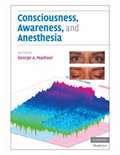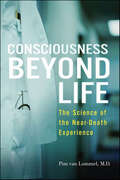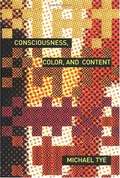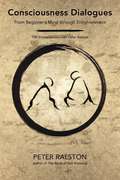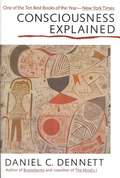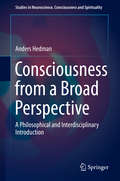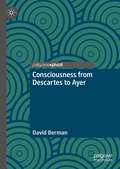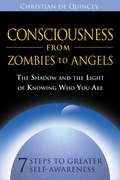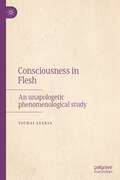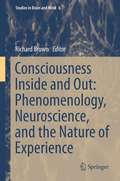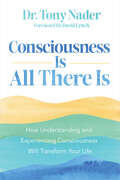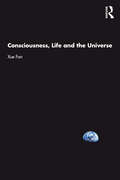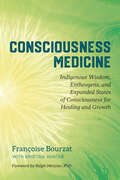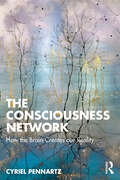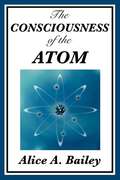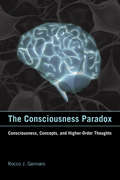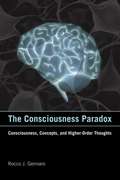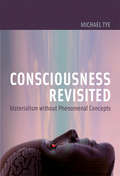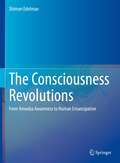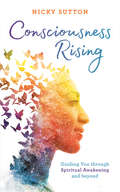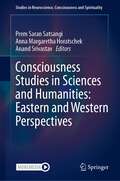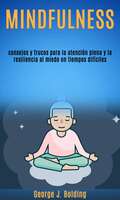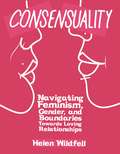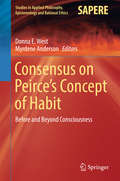- Table View
- List View
Consciousness, Awareness, and Anesthesia
by George A. MashourHypnosis, amnesia, and immobility are three major therapeutic endpoints of general anesthesia. In one to two cases out of a thousand, hypnosis and amnesia are not achieved - often leaving a patient immobile but capable of experiencing and remembering intraoperative events. Awareness during general anesthesia is one of the most dreaded complications of surgery and is feared by patients and clinicians alike. Despite many advances in the field, there are also a number of unresolved questions that persist. Some of the difficulties in the detection and prevention of awareness during anesthesia relate to the underlying complexities of the neuroscientific basis of consciousness. Consciousness, Awareness, and Anesthesia is a multidisciplinary approach to both the scientific problem of consciousness and the clinical problem of awareness during general anesthesia. An international cadre of authors with expertise in anesthesiology, neurobiology, and philosophy provides a cutting-edge perspective. No other book on the subject has drawn from such a breadth of scholarship.
Consciousness Beyond Life: The Science of the Near-Death Experience
by Pim van LommelIn Consciousness Beyond Life, the internationally renowned cardiologist Dr. Pim van Lommel offers ground-breaking research into whether or not our consciousness survives the death of our body. If you enjoy books about near-death experiences, such as those by Raymond Moody, Jeffrey Long, and James Van Praagh; watch televisions shows like Ghosthunters, Touched by an Angel, and Ghost Whisperer; or are interested in works that explore the intersection of faith and science, such as Spiritual Brain, Signature in the Cell, and When Science Meets Religion; you’ll find much to ponder in Consciousness Beyond Life.
Consciousness, Color, and Content
by Michael TyeExperiences and feelings are inherently conscious states. There is something it is like to feel pain, to have an itch, to experience bright red. Philosophers call this sort of consciousness "phenomenal consciousness."
Consciousness Dialogues: From Beginner's Mind through Enlightenment: 150 Conversations with Peter Ralston
by Peter RalstonPeter Ralston responds to 150 questions about consciousness from a global spectrum of people striving to grasp the nature of their own selvesThis illuminating collection of 150 questions and responses between Peter Ralston and a global spectrum of seekers provides a rare and nuanced look at the nature of consciousness and the path to understanding our true selves. Ralston is the author of the groundbreaking trilogy on the existential foundations of the human condition—The Book of Not Knowing, Pursuing Consciousness, and The Genius of Being. Here he has selected inquiries from more than two decades of question-and-answer exchanges with students as they work their way through his communications. The mosaic of viewpoints from an astonishing diversity of real people at all levels of consciousness work yields a narrative that is intricate, wide-ranging, intimate, and emotionally honest. These dialogues expand our understanding of consciousness, test our assumptions, and interrogate the very process of inquiry.
Consciousness Explained
by Daniel Clement Dennett"Consciousness" is notoriously difficult to explain. On one hand, there are facts about conscious experience -- the way clarinets sound, the way lemonade tastes -- that we know subjectively, from the inside. On the other hand, such facts are not readily accommodated in the objective world described by science. How, after all, could the reediness of clarinets or the tartness of lemonade be predicted in advance? Central to Daniel C. Dennett's attempt to resolve this dilemma is the "heterophenomenological" method, which treats reports of introspection non-traditionally -- not as evidence to be used in explaining consciousness, but as data to be explained. Using this method, Dennett argues against the myth of the Cartesian theater -- the idea that consciousness can be precisely located in space or in time. To replace the Cartesian theater, he introduces his own multiple drafts model of consciousness, in which the mind is a bubbling congeries of unsupervised parallel processing. Finally, Dennett tackles the conventional philosophical questions about consciousness, taking issue not only with the traditional answers but also with the traditional methodology by which they were reached. Dennett's writing, while always serious, is never solemn; who would have thought that combining philosophy, psychology, and neuroscience could be such fun? Not every reader will be convinced that Dennett has succeeded in explaining consciousness; many will feel that his account fails to capture essential features of conscious experience. But none will want to deny that the attempt was well worth making.
Consciousness from a Broad Perspective: A Philosophical and Interdisciplinary Introduction (Studies in Neuroscience, Consciousness and Spirituality #6)
by Anders HedmanThis volume offers an introduction to consciousness research within philosophy, psychology and neuroscience, from a philosophical perspective and with an emphasis on the history of ideas and core concepts. The book begins by examining consciousness as a modern mystery. Thereafter, the book introduces philosophy of mind and the mind-body problem, and proceeds to explore psychological, philosophical and neuroscientific approaches to mind and consciousness. The book then presents a discussion of mysterianist views of consciousness in response to what can be perceived as insurmountable scientific challenges to the problem of consciousness. As a response to mysterianist views, the next chapters examine radical approaches to rethinking the problem of consciousness, including externalist approaches. The final two chapters present the author's personal view of the problem of consciousness. Consciousness remains a mystery for contemporary science--a mystery raising many questions. Why does consciousness persist as a mystery? Are we humans not intelligent enough to solve the riddle of consciousness? If we can solve this mystery, what would it take? What research would we need to conduct? Moreover, the mystery of consciousness prompts the larger question of how well the cognitive sciences have actually advanced our understanding of ourselves as human beings. After all, consciousness is not just a minor part of our existence. Without consciousness, we would not be human beings at all. This book aims to increase the accessibility of major ideas in the field of consciousness research and to inspire readers to contribute to the ongoing discussion of the place of consciousness in nature.
Consciousness from Descartes to Ayer
by David BermanThe title is meant to indicate that consciousness is being examined largely within the history of philosophy, and within the period of time from Descartes to Ayer. Investigators aiming to understand consciousness and minds usually try to take account of all individual human minds, so as to have the most data for the most encompassing induction. The problem with that approach is that because of the vastness of the data, its results tend to be vague, lacking the specificity of studies of individuals. On the other hand, the problem with studies of individuals is that they cannot guarantee generality, as the opposing method can. This book's distinctive approach aims at a middle way, getting the best of the two opposing methods by drawing its data from the history of philosophy, especially the history of the great philosophers.
Consciousness from Zombies to Angels: The Shadow and the Light of Knowing Who You Are
by Christian De QuinceyA user-friendly, step-by-step guide to understanding the mind• Presents a practical journey into understanding consciousness--philosophy’s hardest problem, science’s final frontier, and spirituality’s deepest mystery• Offers 7 steps to transform your life using the shadow and the light of consciousnessConsciousness from Zombies to Angels presents a practical, step-by-step “owner’s guide” for the mind that sorts out philosophy’s hardest problem, science’s final frontier, and spirituality’s deepest mystery--what consciousness is, how it works, and why it’s important. Christian de Quincey presents seven simple steps for understanding consciousness and how it can lead to spiritual awareness: observe your language, identify the problem, learn how to look, recognize your patterns, know yourself, embrace your shadow, and practice transformation.All of us exhibit both shadow and light, aspects of ourselves we fear and deny (our inner Zombies) as well as qualities we admire and want to radiate (our inner Angels). The key to a creative and fulfilled life is to integrate both. De Quincey reveals that the way to transformation is to accept ourselves exactly as we are--a work in progress.Readers will learn the difference between “energy talk” and “consciousness talk”; how the body affects the mind, and vice versa; and where to go for help to develop consciousness, heal emotions, or grow spiritually. De Quincey shows how to recognize and break habits and patterns that run your life, how to find out who you really are, and why facing up to your darkest fears will liberate your brightest light as you learn to embrace all of your humanity and experience the power of transformation.
Consciousness in Flesh: An Unapologetic Phenomenological Study
by Yochai AtariaThis book offers an uncompromising and unapologetic phenomenological study of altered states of consciousness in an attempt to understand the structure of human consciousness. Drawing on the philosophy of Merleau-Ponty, it sets out to decipher the inextricable link between consciousness, body, and world. This link will be established through the presentation of in-depth phenomenological research conducted with former prisoners of war (POWs) and senior meditators. Focusing on two such disparate groups improves our understanding of the nature of the subjective experience in extreme situations – when our sense of boundary is rigid and we are disconnected both from the body and the world (POWs); and when our sense of boundary is fluid and we feel unified with the world (meditators). Based on empirical-phenomenological research, this book will explain how the body that is from the outset thrown into the intersubjective world shapes the structure of consciousness.
Consciousness Inside and Out: Phenomenology, Neuroscience, And The Nature Of Experience (Studies in Brain and Mind #6)
by Richard BrownThis volume is product of the third online consciousness conference, held at http://consciousnessonline.com in February and March 2011. Chapters range over epistemological issues in the science and philosophy of perception, what neuroscience can do to help us solve philosophical issues in the philosophy of mind, what the true nature of black and white vision, pain, auditory, olfactory, or multi-modal experiences are, to higher-order theories of consciousness, synesthesia, among others. Each chapter includes a target article, commentaries, and in most cases, a final response from the author. Though wide-ranging all of the papers aim to understand consciousness both from the inside, as we experience it, and from the outside as we encounter it in our science. The Online Consciousness Conference, founded and organized by Richard Brown, is dedicated to the rigorous study of consciousness and mind. The goal is to bring philosophers, scientists, and interested lay persons together in an online venue to promote high-level discussion and exchanging of views, ideas and data related to the scientific and philosophical study of consciousness.
Consciousness Is All There Is: How Understanding and Experiencing Consciousness Will Transform Your Life
by Dr. Tony NaderNEW YORK TIMES AND USA TODAY BESTSELLERFrom a renowned Vedic scholar, leader of the Maharishi Foundations, and Harvard-trained neuroscientist: a radical new paradigm for understanding Consciousness and finding enlightenment, peace, and fulfillmentDr. Tony Nader, a renowned Vedic scholar and neuroscientist, offers a direct path to peace for ourselves and our world that anyone can obtain—simply by delving into our own Consciousness. Dr. Nader provides the methods, tools, and guidance for connecting with our authentic inner nature and understanding how Consciousness is the essence of all existence, including addressing such fundamental questions as:What is the key to a well-lived, flourishing life in which we can all coexist in peace? Can freedom be compatible with law and order?How can we meet all our challenges as individuals and a society, including the environment, genetic engineering, and the rapid development of artificial intelligence?True wellness is a state of profound clarity, peace, and contentment, resulting from connection with our pure Consciousness. By enlivening our coherence between our Consciousness and the external world, we can find our happiest and highest states of ourselves."Consciousness Is All There Is will open doors of perception for you to a new and profound understanding of life."— Marci Shimoff, #1 New York Times best-selling author of Chicken Soup for the Woman's Soul and Happy for No Reason
Consciousness, Life and the Universe
by Xue FanWhat is consciousness? What is life? What is the universe? This book explores these three interconnected questions, providing deep insights into the past, present and future of consciousness research. Consciousness, Life and the Universe builds a unified view of consciousness across biological, chemical and physical scales, tracing the natural connections from the infinitesimally small to the infinitely big; from quantum fields and elementary particles to molecules, cells and living organisms to the cosmos; from the evolution of life to the evolution of the universe and to the future of humanity. The book provides a unified framework for future consciousness studies and identifies the scientific and technological approaches that are essential for further understanding consciousness. Through this pioneering research approach, the book clearly redefines consciousness and life and conceives a plausible view of the origin and nature of the universe. This is a must-read for students and researchers in consciousness studies, cognitive psychology, cognitive science and neuroscience, as well as anyone interested in the biological and physical basis of consciousness and the history and evolution of consciousness research.
Consciousness Medicine: Indigenous Wisdom, Entheogens, and Expanded States of Consciousness for Healing Healing and Growth
by Françoise Bourzat Kristina Hunter"Françoise Bourzat has written an authoritative book on guided psychedelic therapy with important lessons for anyone thinking of either guiding or being guided.” —Michael Pollan via TwitterA comprehensive guide to the safe and ethical application of expanded states of consciousness for therapists, healing practitioners, and sincere explorers Psychedelic medicines also known as entheogens are entering the mainstream. And it’s no wonder: despite having access to the latest wellness trends and advances in technology, we’re no healthier, happier, or more meaningfully connected. Psilocybin mushrooms, ayahuasca, and LSD—as well as other time-tested techniques with the power to shift consciousness such as drumming, meditation, and vision quests—are now being recognized as potent catalysts for change and healing. But how do we ensure that we’re approaching them effectively? Françoise Bourzat—a counselor and experienced guide with sanctioned training in the Mazatec and other indigenous traditions—and healer Kristina Hunter introduce a holistic model focusing on the threefold process of preparation, journey, and integration. Drawing from more than thirty years of experience, Bourzat’s skillful and heartfelt approach presents the therapeutic application of expanded states, without divorcing them from their traditional contexts. Consciousness Medicine delivers a coherent map for navigating nonordinary states of consciousness, offering an invaluable contribution to the field of healing and transformation.
The Consciousness Network: How the Brain Creates our Reality
by Cyriel PennartzWhat is the relationship between consciousness and our brain? Are they one and the same? Who are we really? The Consciousness Network presents a novel account of one of the greatest scientific challenges of the twenty-first century: understanding the connection between brain and mind.The book explores remarkable cases of patients who demonstrate how our impression of reality is created by the brain. Age-old questions about dreams, colour perception, phantom sensations and hallucinations are illuminated by surprising discoveries from the latest brain research. How does consciousness differ from memory, emotions and behaviour? How did it develop during the evolution of life on earth, and does it serve a purpose? Does the brain leave room for free will? In this unique blend of philosophy, history, psychology and neuroscience, Cyriel Pennartz breaks new ground by presenting an original theory of brain and mind, substantiated by brain research in patients and healthy people. This theory, inspired by the seventeenth-century philosopher Spinoza, goes significantly deeper than current thinking based on computer models or artificial intelligence.The Consciousness Network is essential reading for students working at the interface of neuroscience, cognitive psychology, philosophy of mind and cognitive science, as well as anyone interested in consciousness and the brain.
The Consciousness of the Atom
by Alice A. BaileyThe seven lectures presented here were delivered in New York for the purpose of presenting the testimony of science as to the relation of matter and of consciousness; to enable the hearers to observe the identical manifestation of these relations and of certain basic laws in successively higher states of being, and thus to bring to them a realization of the universality of the evolutionary process and its actuality; and to deal somewhat with the nature of the expanded states of consciousness and the enlarged life toward which all mankind is traveling. They thus were intended to serve as an introduction to the more detailed study and application of the laws of life and human enfoldment generally included in the term of "occultism."
The Consciousness Paradox: Consciousness, Concepts, and Higher-Order Thoughts (Representation and Mind series)
by Rocco J. GennaroA defense of a version of the higher-order thought (HOT) theory of consciousness with special attention to such topics as concepts and animal consciousness. Consciousness is arguably the most important area within contemporary philosophy of mind and perhaps the most puzzling aspect of the world. Despite an explosion of research from philosophers, psychologists, and scientists, attempts to explain consciousness in neurophysiological, or even cognitive, terms are often met with great resistance. In The Consciousness Paradox, Rocco Gennaro aims to solve an underlying paradox, namely, how it is possible to hold a number of seemingly inconsistent views, including higher-order thought (HOT) theory, conceptualism, infant and animal consciousness, concept acquisition, and what he calls the HOT-brain thesis. He defends and further develops a metapsychological reductive representational theory of consciousness and applies it to several importantly related problems. Gennaro proposes a version of the HOT theory of consciousness that he calls the "wide intrinsicality view" and shows why it is superior to various alternatives, such as self-representationalism and first-order representationalism. HOT theory says that what makes a mental state conscious is that a suitable higher-order thought is directed at that mental state.Thus Gennaro argues for an overall philosophical theory of consciousness while applying it to other significant issues not usually addressed in the philosophical literature on consciousness. Most cognitive science and empirical works on such topics as concepts and animal consciousness do not address central philosophical theories of consciousness. Gennaro's integration of empirical and philosophical concerns will make his argument of interest to both philosophers and nonphilosophers.
The Consciousness Paradox
by Rocco J. GennaroConsciousness is arguably the most important area within contemporary philosophy of mind and perhaps the most puzzling aspect of the world. Despite an explosion of research from philosophers, psychologists, and scientists, attempts to explain consciousness in neurophysiological, or even cognitive, terms are often met with great resistance. In The Consciousness Paradox, Rocco Gennaro aims to solve an underlying paradox, namely, how it is possible to hold a number of seemingly inconsistent views, including higher-order thought (HOT) theory, conceptualism, infant and animal consciousness, concept acquisition, and what he calls the HOT-brain thesis. He defends and further develops a metapsychological reductive representational theory of consciousness and applies it to several importantly related problems. Gennaro proposes a version of the HOT theory of consciousness that he calls the "wide intrinsicality view" and shows why it is superior to various alternatives, such as self-representationalism and first-order representationalism. HOT theory says that what makes a mental state conscious is that a suitable higher-order thought is directed at that mental state. Thus Gennaro argues for an overall philosophical theory of consciousness while applying it to other significant issues not usually addressed in the philosophical literature on consciousness. Most cognitive science and empirical works on such topics as concepts and animal consciousness do not address central philosophical theories of consciousness. Gennaro's integration of empirical and philosophical concerns will make his argument of interest to both philosophers and nonphilosophers.
Consciousness Reconsidered
by Owen FlanaganConsciousness is neither miraculous nor ultimately mysterious. In this broad, entertaining, and persuasive account, Flanagan argues that we are on the way to understanding consciousness and its place in the natural order. No aspect of consciousness escapes Flanagan's probe. Qualia, self-consciousness, disorders such as blindsight, various kinds of amnesia, and multiple personalities all find a place in this powerful synthetic theory that contends that consciousness is real, plays an important causal role, and resides in the brain.
Consciousness Revisited: Materialism without Phenomenal Concepts (Representation and Mind series)
by Michael TyeFour major puzzles of consciousness philosophical materialism must confront after rejecting the phenomenal concept strategy.We are material beings in a material world, but we are also beings who have experiences and feelings. How can these subjective states be just a matter of matter? To defend materialism, philosophical materialists have formulated what is sometimes called "the phenomenal-concept strategy," which holds that we possess a range of special concepts for classifying the subjective aspects of our experiences. In Consciousness Revisited, the philosopher Michael Tye, until now a proponent of the the phenomenal-concept strategy, argues that the strategy is mistaken.A rejection of phenomenal concepts leaves the materialist with the task of finding some other strategy for defending materialism. Tye points to four major puzzles of consciousness that arise: How is it possible for Mary, in the famous thought experiment, to make a discovery when she leaves her black-and-white room? In what does the explanatory gap consist and how can it be bridged? How can the hard problem of consciousness be solved? How are zombies possible? Tye presents solutions to these puzzles—solutions that relieve the pressure on the materialist created by the failure of the phenomenal-concept strategy. In doing so, he discusses and makes new proposals on a wide range of issues, including the nature of perceptual content, the conditions necessary for consciousness of a given object, the proper understanding of change blindness, the nature of phenomenal character and our awareness of it, whether we have privileged access to our own experiences, and, if we do, in what such access consists.
The Consciousness Revolutions: From Amoeba Awareness to Human Emancipation
by Shimon EdelmanThis book is about all things consciousness, great and small. It starts by pointing to the key characteristic of consciousness, without realizing which it cannot be understood: like everything else about the mind, it is fundamentally a kind of computation. Among many other matters, this explains: how it is that we share some aspects of consciousness with bacteria; how it can arise in artificial machines and not just living ones; how the empty cocoon of the self that it spins ends up pretending to be the butterfly; and how consciousness dooms this virtual butterfly to the splendor and the suffering of being awake and aware. Unlike most other books on consciousness, this one includes a discussion of some possible ways whereby we, pinned like butterflies by our species’ history and socioeconomic circumstances, can awake to our collective predicament and join forces to do something about it. It should be of interest to all readers who care about the nature of our lived experience — and about our survival, which depends on developing critical consciousness of our dire situation and the social dynamics that shape it.
Consciousness Rising: Guiding You through Spiritual Awakening and beyond
by Nicky SuttonNicky Sutton offers this transformative guide to spiritual awakening, giving advice on manifesting, meditating and moving through any challenging parts of the journey from awakening to rebirth.A compassionate guide to the process and challenges of spiritual awakening, from breakthrough and enlightenment to finding peace, balance and connection with your higher self.How do you know if you're experiencing a spiritual awakening? If your sense of self is dissolving, or your perceptions of reality and purpose are transforming uncontrollably, then it's possible. Sometimes a significant life event, such as a loss, sudden insight, societal change, or a mystical experience, can cause a spontaneous and unexpected shift within us. Spiritual and meditation guide Nicky Sutton is here to help you navigate the waves of transformation as you awaken to further revelations. In this book she breaks down the stages of spiritual awakening and offers compassionate, practical advice to enhance your journey - including tips for manifesting, meditating, and developing your psychic and intuitive abilities. You are an ever-evolving being on the road to greater understanding, and this powerful and reassuring guide is here to help you rise to the challenge of spiritual awakening and find peace, balance, and connection with your higher self.
Consciousness Studies in Sciences and Humanities: Eastern and Western Perspectives (Studies in Neuroscience, Consciousness and Spirituality #8)
by Prem Saran Satsangi Anna Margaretha Horatschek Anand SrivastavThis book presents consciousness models from Eastern and Western perspectives that accommodate current scientific research in the natural sciences and humanities, from neurological experiments through philosophical enquiries to spiritual approaches. It offers up to date research from key disciplines in consciousness studies ranging from neurology, quantum mechanics, algorithmic science, mathematics, and astrophysics to literary studies, philosophy, and (comparative) theology. The volume examines the dichotomy between Western and Eastern perceptions of consciousness – where consciousness is perceived as brain activity by Western scientists, and as a divine presence by various religions, especially in the East. The essays contextualize each other and reciprocally illuminate the potential and limits of the respective approaches. The texts aim at a transdisciplinary and transcultural exchange of ideas in consciousness studies and address a readership from interested lay-readers to experts of the field. The volume is of interest to researchers of consciousness studies.
consejos y trucos para la atención plena y la resiliencia al miedo en tiempos difíciles
by George J. BoldingLo más probable es que veas al mundo con más paz y compasión cuando termines de leer este libro. Creo firmemente que el guerrero de la paz que hay dentro de ti se despertará con las palabras ocultas en este libro. A lo largo de este libro aprenderás: •-Cómo la atención plena puede ayudarte a reducir el estrés •-La verdadera naturaleza de tu mente •-Cómo transformar tu mente •-Los retos y beneficios de la atención plena •-El entrenamiento formal e informal de la atención plena •-Y mucho más. Es exactamente por eso que esta inspiradora guía de meditación de atención plena incluye un capítulo especial sobre la incorporación de la meditación de atención plena en tu agitada vida diaria. Un libro fácil de seguir sobre meditación y atención plena para principiantes.
Consensuality
by Helen WindfellThere are infinite possibilities in human relationships, but the fairytale ideal of companionship does not exist for most people. In Consensuality, Helen Wildfell and her co-adventurers detail the process for creating or finding a healthy, successful relationship as well as common pitfalls and how to avoid them, like gender identity, sexual boundaries, power struggles, and emotional dysfunction. Overcoming regret and resentment, the authors describe a journey towards a respectful social environment. Their experiences lead to lessons of self-empowerment and communication tips for building healthy partnerships. We recognize their preferences and boundaries. We discuss how those fit with our own preferences and boundaries. Filled with personal descriptions of the complex layers in human interaction, the book combines gender studies with memoir to truly make the personal political.
Consensus on Peirce’s Concept of Habit: Before and Beyond Consciousness (Studies in Applied Philosophy, Epistemology and Rational Ethics #31)
by Donna E. West Myrdene AndersonThis book constitutes the first treatment of C. S. Peirce s unique concept of habit. Habit animated the pragmatists of the 19th and early 20th centuries, who picked up the baton from classical scholars, principally Aristotle. Most prominent among the pragmatists thereafter is Charles Sanders Peirce. In our vernacular, habit connotes a pattern of conduct. Nonetheless, Peirce s concept transcends application to mere regularity or to human conduct; it extends into natural and social phenomena, making cohesive inner and outer worlds. Chapters in this anthology define and amplify Peircean habit; as such, they highlight the dialectic between doubt and belief. Doubt destabilizes habit, leaving open the possibility for new beliefs in the form of habit-change; and without habit-change, the regularity would fall short of habit conforming to automatic/mechanistic systems. This treatment of habit showcases how, through human agency, innovative regularities of behavior and thought advance the process of making the unconscious conscious. The latter materializes when affordances (invariant habits of physical phenomena) form the basis for modifications in action schemas and modes of reasoning. Further, the book charts how indexical signs in language and action are pivotal in establishing attentional patterns; and how these habits accommodate novel orientations within event templates. It is intended for those interested in Peirce s metaphysic or semiotic, including both senior scholars and students of philosophy and religion, psychology, sociology and anthropology, as well as mathematics, and the natural sciences. "
